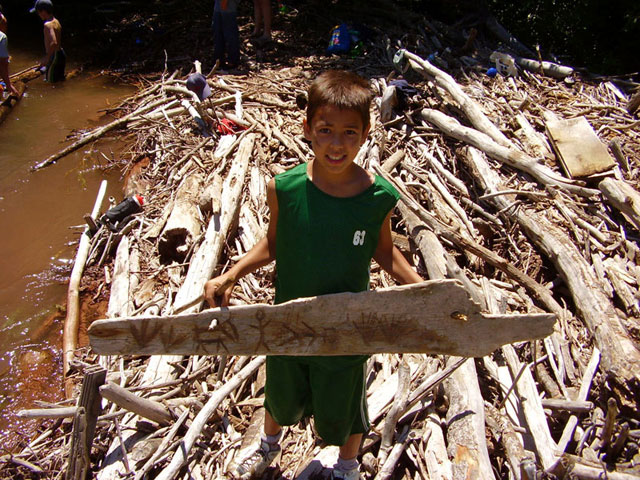|
DAN COLLINS
The Interactive Watershed
This project involves a series of physical and computer-based works flowing from a "participatory mapping project" conducted by the artist in the San Miguel River basin in Southwestern Colorado. The project includes a suite of interactive mapping tools (GIS based), graphic elements, and sculptural objects that invite local participation related to "placemaking" and watershed education. The artist produced a comprehensive "cultural map" of the Telluride bio-region, a wealth of online resources, a traveling exhibition, a public sculpture, an educational outreach program, and a series of publications. This site specific artwork, a cultural virus situated at the administrative core of the local community, seeks to act as a change agent to expand public awareness of the watershed and encourage cultural practices that celebrate the unique identity of the bio-region. This research piggybacks on a Geographic Information System (GIS) developed by San Miguel County. In order to represent subjective experiences of place, a "cultural layer" has been created that will appear alongside the pragmatic layers already part of the county GIS. This project is site-specific. But the work is not "sited" in a way that valorizes its status as an "artwork." The primary component of the work--a GIS layer--will reside on the server of the San Miguel County Planning Office. This constitutes a different notion of "situated" practice. The idea is to position evidence of cultural expression at the center of the decision making apparatus--not at the periphery where "art" is generally relegated. The work is a cultural virus that has jumped the boundary from culturally acceptable sites into the very core of those institutions defining public policy. The underlying methodology employed by this artist is called Participatory Action Research (PAR)--an explicitly political, socially-engaged approach to knowledge generation. Participatory Action Research provides members of a given community a method to identify issues of concern, gather relevant information, and explore and implement possible solutions. The "interactive watershed tools"--a set of GIS protocols--designed and deployed for the project provide opportunities for both creative expression and political engagement. The ultimate goal of the project is to reveal “hidden cultural assets” that enable an informed constituency to better resist the negative consequences of development and growth in the watershed. I see the potential for expanding the "participatory mapping" concept used in this project to help with real change in landscapes as diverse as the Phoenix urban core, the Navajo reservation, the rapidly changing environment of central Europe (specifically the Czech Republic), and to AIDS activism and education in Kenya. The core audience is a group of some 20 volunteer participants who have agreed to create a unique creative work that responds to the San Miguel River watershed. These projects will be used to generate a "cultural layer" for the County's Geographic Information System (GIS). Following this first step, anyone living in the watershed with an interest in adding to the GIS will be invited to upload their own projects. Still a larger cross section of the local population will be engaged through conventional exhibitions, lectures, and classroom presentations. Finally, an international audience will be reached through publications and conferences.
|
